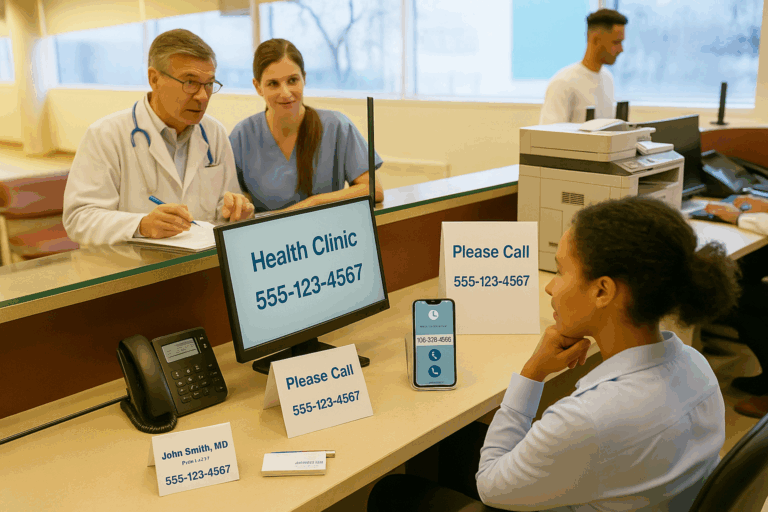Unlocking patient satisfaction and improving office efficiency are paramount goals for healthcare practices. The solution lies in incorporating HIPAA-compliant texting into your toolkit. By securely communicating with patients and streamlining internal workflows, you can enhance patient experiences and optimize operations.
How Text Messaging Can Be HIPAA-Compliant
To say communication has undergone a sea change in the last twenty years would be an understatement. First, we had voicemail, then email, and finally, text messaging. Each has made delivering information easier and more convenient, but they’ve also raised privacy concerns, particularly in healthcare. That’s where HIPAA and HIPAA compliance come into play.
Though HIPAA was created to reform the health insurance market, its impact has had far greater reach, including how and to whom protected health information (PHI) can be shared. For example, the HIPAA law’s privacy provisions were intended to prevent healthcare fraud and abuse but created standards ensuring that electronic transmissions of certain health information were secure. Unfortunately, that dramatically affected providers’ ability to leave voice mail messages and what and how could be transmitted via email and text messages to patients and between healthcare colleagues.
HIPAA does not prohibit text messaging, but specific requirements must be met. There are good reasons, as significant risks keep healthcare providers up at night. These include:
- Texting protected health information to the wrong individual
- Patients inadvertently deleting critical information
- Lack of verification of receipt, leaving providers uncertain as to whether critical information has been received
- Messages remaining on a device that could be lost, stolen, or breached, and information being shared with an unauthorized individual
As a result of these genuine concerns, HIPAA has established safeguards surrounding text messaging. For example, access controls must be in place, and data must be encrypted. In addition, messages must be protected against deletion, destruction, and alteration, and an audit trail must be maintained to track and monitor activity if necessary.
The Challenges of Combining HIPAA With Texting
The texting platform on your phone lacks essential controls, posing significant challenges for healthcare offices. Physicians and professionals instinctively turn to their phones for efficient communication with patients and colleagues. Although messages without personal identifiers are HIPAA compliant, texts remain vulnerable to interception, storage on carrier servers, and unauthorized access.
The risks extend beyond inadvertently sharing patients’ personal data. Healthcare practices face the real possibility of HIPAA breaches, with daily fines of up to $63,973 for violations. Consequently, healthcare professionals should exclusively use applications and technology explicitly designed for the industry by experts well-versed in HIPAA’s privacy rules.
Benefits of Secure HIPAA Patient Texting and Healthcare Communications
For a texting platform to be HIPAA-compliant, it must be a closed system that only authorized users can access. While texting with patients is not strictly secure because their cell phones are outside of the system’s platform and can’t be encrypted, that does not preclude sending non-medical information about appointments, directions to the facility, and other administrative points. Keep in mind that patient messages can only be sent to those who have opted into the system.
Texting improves patient satisfaction and experience. It creates simplified access from patient to the office and from office to patient, reducing the incidence of phone tag. It makes setting and confirming (or canceling) appointments easy and can even be used to provide links to lab tests, patient forms, prescription renewals, and billing information. Removing these time-consuming tasks from phone and front office to text saves hundreds of hours otherwise spent answering or making phone calls and improves service delivery and staff morale.
Texting eliminates the all-too-familiar situation of patients standing at check-in desks, waiting for staff members to attend to them. It dispenses hold times and the need for an immediate response. Once a secure digital message is sent to a patient, it can be answered immediately or asynchronously, allowing those involved to continue pursuing other tasks. Texts can also be automated so they are easily sent to the patient population or individual groups.
From a professional staff perspective, a HIPAA-compliant text platform removes all concerns of risk and HIPAA violations while facilitating faster internal communication regarding patients. In addition, it allows providers to communicate directly to patients with complete certainty that they are reaching the right person. It lets them maintain their privacy by assigning unique originating numbers.
Texting directly with colleagues on supported, secured devices within a practice or facility is even more important to staff. A HIPAA-compliant communication system like RingRx means that staff can digitally discuss protected health information while texts remain internal. This can make a real difference in the speed with which diagnoses can be confirmed and treatment plans put into place.
The applications for text messaging in healthcare are only beginning to be fully realized. Medical organizations are using them to request feedback on patient satisfaction and to request that patients post reviews of their experience on online platforms. They are being used to remind patients of upcoming appointments or that it is time to schedule an appointment, to confirm that patients are coming to a scheduled appointment or to offer an easy way to cancel and reschedule. Links to patient intake forms that are normally filled out in office waiting rooms can be sent ahead of time to improve efficiency and speed up the time between patient arrival and examinations. Patients can be notified that lab results are in, prescription refills are available, or invoices are past due, complete with a payment link.
Adding a HIPAA-compliant text platform to your medical organization provides an invaluable efficient resource that protects patient data and privacy, responds to patient demand, and meets the challenges of today’s modern healthcare demands.
How RingRx Enables HIPAA-Compliant Texting
RingRx texting helps you stay connected with patients and co-workers using their preferred communications channels. It improves practice workflow, so patients receive better care, faster. RingRx makes it easy to send fast and convenient text messages that speed up crucial communications.
Here’s how RingRx makes texting work for you:
- Patient Texting: Stay connected with patients using their preferred communications channel.
- Unlimited Texting: Speed up crucial communications by sending secure text messages to patients and your team.
- Mobile App/Portal: Send and receive messages from your Mobile App or our convenient RingRx Portal.
- Text Message Logging: Log copies of inbound and outbound messages to a mailbox for archiving or compliance purposes.
- Unique Numbers for Each User: Maintain confidentiality and ensure texts get to the right person or department.
- SMS Auto Responder: Set up automatic text responses to let patients or team members know when to expect an action.
- HIPAA Compliance: Secure cloud-based platform built with strict security standards for modern healthcare practices.
- Group Texting: Send confidential group texts between colleagues to reduce errors and improve patient handovers.
- Secure Team Texting: Send and receive encrypted texts with co-workers using the Mobile App or RingRx Portal.
By leveraging RingRx’s HIPAA-compliant texting solution, healthcare practices can enhance patient communication, streamline workflows, and ensure compliance with privacy regulations. RingRx’s commitment to secure messaging and robust features empowers healthcare providers to embrace the benefits of text messaging while maintaining data security and patient confidentiality.
For more on HIPAA-compliant texting, take a look at our guide here. Please note, This guide does not constitute legal advice. Please consult with your own legal counsel for standards and practices that are best suited for your organization.




